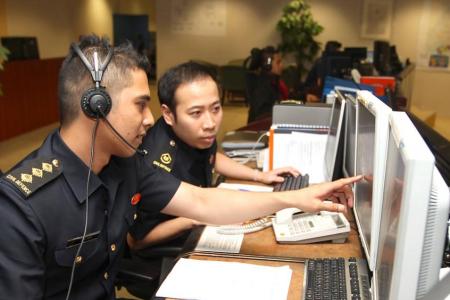New framework to differentiate 995 calls
Life-threatening cases will get priority amid rising number of false alarms
The Singapore Civil Defence Force (SCDF) has started differentiating 995 calls based on the severity of patients' medical conditions to deploy resources better and faster to more severe cases.
The shift to a new Emergency Medical Services (EMS) Tiered-Response framework comes amid tightening manpower resources and a surging number of 995 calls, with a rising proportion of false alarms and non-emergency calls among them.
Last year, SCDF handled close to 180,000 emergency calls, or about 500 a day.
Of these, almost 19,000, or about 10 per cent, were false alarms and for non-urgent ailments such as constipation and chronic cough.
The percentage was an increase from the 5.3 per cent in 2015 and 4.6 per cent in 2014.
Law and Home Affairs Minister K. Shanmugam said that while SCDF has boosted the number of ambulances, paramedics and emergency medical technicians to deal with the rising demand, it is not a sustainable solution, and the number of calls will only rise as Singapore faces an ageing population.
"If we don't do something, we will not be able to provide the necessary care to the most critical emergency cases," said Mr Shanmugam, who announced the framework at the SCDF workplan seminar yesterday.
Previously, EMS responses were based on a single-tier system, where SCDF responded to all emergency medical and trauma cases on a first-come, first-served basis within the standard 11 minutes.
Under the new framework, which will be implemented in phases over the next few years, callers who do not require emergency response will be advised to seek outpatient treatment at nearby clinics.
If we don't do something, we will not be able to provide the necessary care to the most critical emergency cases.Law and Home Affairs Minister K. Shanmugam
Those who insist on visiting a hospital will be asked to either call for private non-emergency medical transport services or make their own way to the hospital.
Under the first phase, which began on April 1 and is set to last until 2019, the SCDF 995 Operations Call Centre started sorting calls based on a series of quick questions.
It has trained 230 fire and rescue specialists who will ride fire bikes equipped with medical bags, and will typically respond to severe emergency cases - the top of the four-tiered framework - with an ambulance.
Later this month, SCDF will roll out Fire Medical Vehicles - engineered and built by home-grown engineering company Hope Technik - which will be deployed in less severe emergencies such as traffic accidents.
Mr Shanmugam said SCDF will partner the Ministry of Health (MOH) later this year to train at least 300 residents from each constituency with life-saving skills.
Associate Professor Marcus Ong, director of the unit for pre-hospital emergency care in MOH, said the tiered framework is similar to the way emergency departments operate in hospitals.
"The priority is to save lives and treat those who are in most urgent need," he said.
FOR MORE, READ THE STRAITS TIMES TODAY
Get The New Paper on your phone with the free TNP app. Download from the Apple App Store or Google Play Store now



